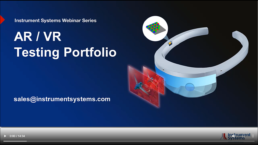
AR/VR Industry Solutions
AR/VR (Augmented Reality and Virtual Reality) devices are used in various fields of applications. AR/VR glasses are used in production lines as well as in the medical, transportation, and entertainment industries. It has also been found more recently in aerospace technology, specifically in F-35 military AR helmets.
One AR/VR device is the use of head-mounted displays (HMD) or head-up displays (HUD) which project a computer-generated image. The wearer is immersed in a virtual world (virtual reality) and receives additional information (augmented reality) superimposed onto the real image. Most HMD manufacturers use displays that are worn very close to the eye.
Display or calibration errors distract from the wearer’s sense of immersion in the virtual world. In quality assurance they must be reliably recognized and evaluated. This evaluation is done with instruments that provide very fast and precise measurements for luminance and chromaticity of high dynamic range displays. Such instruments include small-spot and high-sensitivity probes for measuring both OLEDs and micro and small measurement requirements. The closer the measuring instrument mimics the human eye, the clearer the entire field of vision and the relevant defects can be more easily recognized. Such probes are part of our CA-410 Display Color Analyzer product line.
There are also challenges with AR/VR as it relates to large field of vision and near-to-eye displays. A common effect of optical solutions developed for AR/VR display measurement is distortion in images often captured by the field of view (FOV). These errors or distortions in perception are addressed by measuring the positioning, brightness, color and contrast that contribute to the realistic rendering of the artificial object.
Today many VR goggles cover the entire horizontal field of vision of the human eye. To enable realistic measurements, an imaging system must therefore capture all areas of the virtual image. The close proximity of the display to the eye also magnifies display defects, making them more prominent to the wearer. At the same time, the resolution of these displays is constantly increasing, creating an illusion that is realistic. To ensure reliable results, it is pertinent that the instruments used in measuring these defects are precisely calibrated. Easily providing measurements that can accurately determine excellent resolution, at pixel level.
Konica Minolta Sensing and Instrument Systems offer established and recognized measuring systems for innovative AR/VR applications. These display measuring systems (DMS) are based on the CAS series of high-end spectrometers from Instrument Systems. The compact system mimics the human perception by giving both a precise angle and time-resolved measurement that is virtually unrivaled in the market. They can be equipped with custom optics and extensive accessories, and to simulate ambient lighting and temperature. Software tools are also available for AR/VR applications, include eye box mapping and flicker.
The LumiTop system combined with the CAS spectrometer is one of the few 2D color measuring systems available on the market with both spectroradiometric precision and extremely short measuring times. For many years the LumiTop system has been an integral part of the assembly lines of some of the biggest display manufacturers. For use in the measurement of AR/VR displays, the LumiTop is supplemented with a special AR/VR lens. Konica Minolta Sensing also offers its highly accurate CS-3000 series of spectroradiometers. Offering pupil-size spot measurement with a specialized accessory for HMD applications makes it ideal for R&D spectral data verification.

